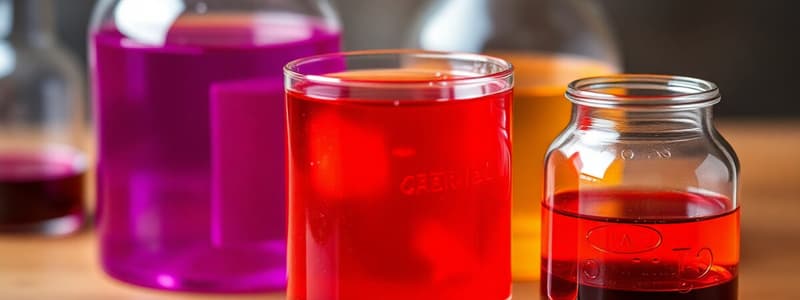Podcast
Questions and Answers
Why would handling strong acids require specialized protective equipment and ventilation?
Why would handling strong acids require specialized protective equipment and ventilation?
- Strong acids react violently with other chemicals, potentially causing explosions if not handled carefully.
- Strong acids are primarily dangerous when ingested, requiring precautions against accidental swallowing.
- Strong acids emit radioactive particles, necessitating shielding and monitoring to prevent radiation exposure.
- The corrosive properties of strong acids can cause severe burns and respiratory damage upon contact or inhalation. (correct)
If you were to dilute a strong acid with water, what would be the most important safety precaution?
If you were to dilute a strong acid with water, what would be the most important safety precaution?
- Add acid to the water slowly while stirring to dissipate heat. (correct)
- Add water to the acid quickly to minimize splashing.
- Mix the acid and water in a sealed container to prevent fumes from escaping.
- Cool both the acid and water in an ice bath before mixing to control the reaction.
How does the concentration of an undissociated weak acid in an aqueous solution compare to that of a strong acid at the same molar concentration?
How does the concentration of an undissociated weak acid in an aqueous solution compare to that of a strong acid at the same molar concentration?
- The weak acid will have a significantly higher concentration of undissociated molecules. (correct)
- The weak acid will have a significantly lower concentration of undissociated molecules.
- The weak acid and strong acid will have approximately the same concentrations of undissociated molecules.
- The concentration of undissociated molecules depends on the specific acid, regardless of its strength.
What is the primary difference between the corrosive action of a strong acid versus a weak acid on a metal surface?
What is the primary difference between the corrosive action of a strong acid versus a weak acid on a metal surface?
Which laboratory practice would best minimize the risk of chemical burns when working with both strong and weak acids?
Which laboratory practice would best minimize the risk of chemical burns when working with both strong and weak acids?
Why is it recommended to use eye protection when working with bases?
Why is it recommended to use eye protection when working with bases?
Acids and bases are described as having opposite properties. What critical behavior results from this?
Acids and bases are described as having opposite properties. What critical behavior results from this?
A student accidentally spills a small amount of acid on their skin. What immediate action should they take?
A student accidentally spills a small amount of acid on their skin. What immediate action should they take?
Which of the following practices is essential for maintaining safety while working with chemical substances in a laboratory?
Which of the following practices is essential for maintaining safety while working with chemical substances in a laboratory?
What distinguishes a strong base from a weak base?
What distinguishes a strong base from a weak base?
How should you place the cap of a bottle containing a chemical substance on the table during work, according to safety guidelines?
How should you place the cap of a bottle containing a chemical substance on the table during work, according to safety guidelines?
What is the primary purpose of the danger sign on labels of harmful chemicals?
What is the primary purpose of the danger sign on labels of harmful chemicals?
You notice that you have spilled base on the table in the laboratory. What is the correct procedure?
You notice that you have spilled base on the table in the laboratory. What is the correct procedure?
Flashcards
Acids
Acids
Substances often found in foods, known for a sour taste and corrosive nature.
Common Lab Acids
Common Lab Acids
Examples include hydrochloric acid (HCl), sulfuric acid (H₂SO₄), and nitric acid (HNO₃).
Corrosive Property
Corrosive Property
Acids that cause significant damage to materials they contact.
Strong Acids
Strong Acids
Signup and view all the flashcards
Aqueous Acid Solutions
Aqueous Acid Solutions
Signup and view all the flashcards
Bases
Bases
Signup and view all the flashcards
Strong Bases
Strong Bases
Signup and view all the flashcards
Neutralization
Neutralization
Signup and view all the flashcards
First aid for acid/base exposure
First aid for acid/base exposure
Signup and view all the flashcards
Eye protection when using chemicals
Eye protection when using chemicals
Signup and view all the flashcards
Burning/Etching
Burning/Etching
Signup and view all the flashcards
Danger Symbol on Chemicals
Danger Symbol on Chemicals
Signup and view all the flashcards
Sodium Hydroxide
Sodium Hydroxide
Signup and view all the flashcards
Study Notes
- Many foods contain acids which have a sharp taste and strong odor.
- Strong acids are corrosive.
- Lemonade and lemons contain citric acid, which is a weak acid.
- Hydrochloric acid (HCl), sulfuric acid (H2SO4), and nitric acid (HNO3) are acids used in laboratories.
- Acids are divided into two groups which are weak acids and strong acids.
- Strong acids are highly corrosive, like hydrochloric, nitric and sulfuric acid.
- There is an X sign on bottle labels that denotes danger of corrosion, with the words "harmful substance".
- Acids generally dissolve in water, creating aqueous solutions, which also have corrosive properties.
- Aqueous solutions of weak acids are less corrosive compared to those of strong acids.
Studying That Suits You
Use AI to generate personalized quizzes and flashcards to suit your learning preferences.
Description
Acids have a sharp taste and strong odor. Strong acids are corrosive. Acids are divided into weak and strong acids. Aqueous solutions of acids have corrosive properties, with strong acids being more corrosive than weak acids.




